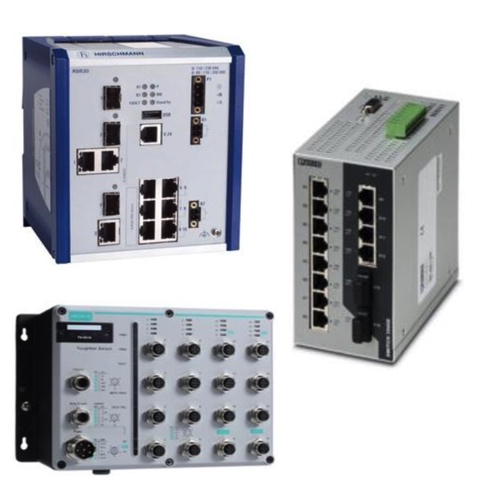Din Rail Ethernet Switches

Ethernet switches that are mounted on a DIN rail are vital building blocks in an industrial Ethernet network. They provide robust and reliable connectivity in what can often be harsh industrial environments. These switches are mounted on DIN rails, ensuring secure and space-efficient installation within industrial control panels. Ethernet switches that are mounted on a DIN rail can be either managed or unmanaged. Managed switches allow advanced configurations, monitoring, and redundancy mechanisms that enhance both security and performance. Unmanaged switches are simplicity itself; just plug them in.
These Ethernet switches for industrial use are built for durability, with many of them supporting Power over Ethernet (PoE) capabilities that enable them to power a range of devices directly through Ethernet cables. Certain models include advanced security features that help ensure the integrity of the network, while many of these switches also contain redundancy mechanisms that help ensure constant connectivity. In environments like factory floors where disruptions cannot be tolerated, networking might require something like these industrial Ethernet switches.
More Information about DIN Rail Ethernet Switches
Ethernet switches that are designed to be attached to DIN rails are meant to be easy to control and to scale up when necessary. Network operators can adjust the settings on the managed switches, so they work exactly as needed—and these managed devices can be not only the switches but also the ports on the switches. In more specialized applications, this sort of control may be essential—and switch manufacturers provide an astounding variety of managed Ethernet switches.
FAQs
How does the DIN rail mounting of an Ethernet switch affect the Ethernet transmission in an industrial network of critical infrastructures?
The DIN rail mounting of an Ethernet switch ensures secure and stable installation in industrial networks, reducing vibration and environmental interference, which enhances reliable Ethernet transmission in critical infrastructures.
Industrial Ethernet Switch: How to Select
4 things to consider when selecting Ethernet switches.
Should the switch be managed or unmanaged? Unmanaged switches receive data from connected devices and route it to the desired destination. Managed switches perform the same functions as unmanaged switches, with the added benefit of being able to configure, manage and monitor the Local Area Network (LAN).
What types of devices will be connected to the switch and do they require power? If the devices require power, a Power Over Ethernet (POE) switch will be needed. This type of switch provides power to the devices that are connected to it, as long as those devices are designed for the same type of power. This is very common in IP cameras and surveillance equipment.
How many devices will connect to the switch? Ensure that the switch has enough available ports to accommodate all devices, with spare ports available for future expansion.
How much data will the switch transfer? If the switch is going to handle large amounts of data, it is going to need to operate at high enough speeds to accommodate it. The most common options are Fast and Gigabit. Fast allows up to 100 megabytes per second to be transferred, while Gigabit allows up to one Gigabit per second.


